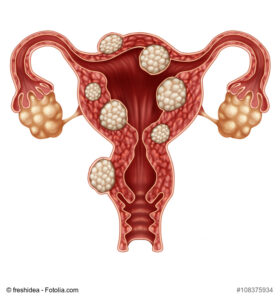Myth and misinformation can hinder women's health, particularly when asking the right questions to a fibroid specialist.
While 70-80% of women may encounter fibroids in their lifetime, many remain unfamiliar with uterine fibroids and their available treatment options.
If you’re living with uterine fibroids, we are here to help by providing timely and helpful information to help you better understand your diagnosis.
Continue reading to learn more about common myths and get answers to frequently asked questions about fibroid tumors.

Fibroids are non-cancerous growths that develop from the muscle tissue of the uterus. While they're occasionally referred to as "fibroid tumors," it's important to note that they are benign.
Polyps, on the other hand, are usually made of endometrial tissue and are also typically benign.
Cysts, however, form on the ovaries and can potentially be malignant. When you hear the term "uterine tumors," it generally signifies uterine fibroids, which are non-cancerous growths.
Uterine cancer, in contrast, refers to the malignant growth of cells within the uterus. Understanding the distinctions between these terms is essential for accurate discussions about women's health.
Fibroids are typically non-cancerous and seldom undergo malignant transformation. The contrast in symptoms between a malignant growth and a benign fibroid plays a crucial role in aiding your doctor in distinguishing between the two.
In extremely rare instances, cancer is detected during fibroid removal surgery.
There is no one symptom that will alert you to the fact that you have uterine fibroids.
Many women have uterine fibroids at some point, but most are asymptomatic. If symptoms do occur, the most common ones include heavy menstrual bleeding, prolonged periods, or pelvic pain, but there are other symptoms that women can experience.
Treatment isn't necessary if you don’t experience symptoms, and many fibroids will shrink over time, especially after menopause.
A variety of treatment options are available to reduce symptom occurrence for those searching for relief. For women who want a non-surgical alternative, want to preserve their uterus, or want a quicker recovery period, uterine fibroid embolization (UFE) may be recommended.
Fibroids typically grow in alignment with hormone levels, which is why symptoms worsen during menstruation. This is also why fibroids may develop during pregnancy but shrink after menopause.
During UFE, our experienced fibroid specialists cut off the blood flow to existing fibroids, causing them to shrink over time. It is rare for fibroids to regrow after treatment. In one study, only 5% of women needed additional treatment after UFE.
One popular home remedy for fibroids is castor oil compresses. In this process, a piece of cloth soaked in castor oil and pressed against the affected body part.
The truth is, an external application can’t impact internal growths, and these compressions are ineffective in treating fibroid tumors or their symptoms.
Now that we’ve debunked the major fibroid myths, we want to share seven common questions and answers to help you better understand a fibroid diagnosis.
Fibroids develop when muscle cells within the uterine wall start growing abnormally. The exact cause of their development is not fully understood, but genetics and hormonal factors are believed to play a role.
No, there are four types of fibroids, classified by location. Understanding these distinctions between them can be crucial for tailored treatment decisions and long-term symptom relief.
The short answer is maybe. The impact of fibroids varies from person to person. While many individuals with fibroids experience no symptoms, others may face issues such as heavy menstrual bleeding, pelvic pain, or fertility challenges, depending on the size and location of the fibroids.
An interventional radiologist is a specialist who uses minimally invasive image-guided procedures to diagnose and treat various conditions, including uterine fibroids. They often perform procedures like UFE or MRI-guided focused ultrasound to manage fibroids without the need for traditional and invasive surgery.
Various treatment options exist for fibroids based on their size, location, and symptoms. One effective fibroid treatment option is UFE. This minimally invasive procedure blocks the blood supply to the fibroids, leading to their shrinkage and symptom relief.
UFE provides relief from fibroid symptoms without the need for extensive scarring or extended hospital stays. This procedure eliminates the necessity for general anesthesia, shortens the recovery time, preserves your uterus, and offers rapid symptom relief.
Following your UFE treatment, you can expect symptom improvement within a few days, but complete recovery may take up to two weeks. Over the subsequent weeks, you should notice both symptom relief and a reduction in the size of your fibroids.
Your reproductive health matters to us.
If you or a loved one live with symptomatic fibroids, you don’t have to experience them forever.
It’s time to forget those harmful fibroid myths and get answers to your important treatment questions. Our specialists at Houston Fibroids are here to help.
We encourage you to schedule a fibroid treatment consultation today, where we will help you understand your diagnosis and, together, decide if you’re a good candidate for UFE.
As leading fibroid specialists in Houston, we can help you get back to doing the things you love – free of pain and symptoms associated with this diagnosis.

Scheduling
Please contact our dedicated specialists to schedule a consultation today.
2025 Houston Fibroids. All rights reserved. Website Design by Healthcare Success